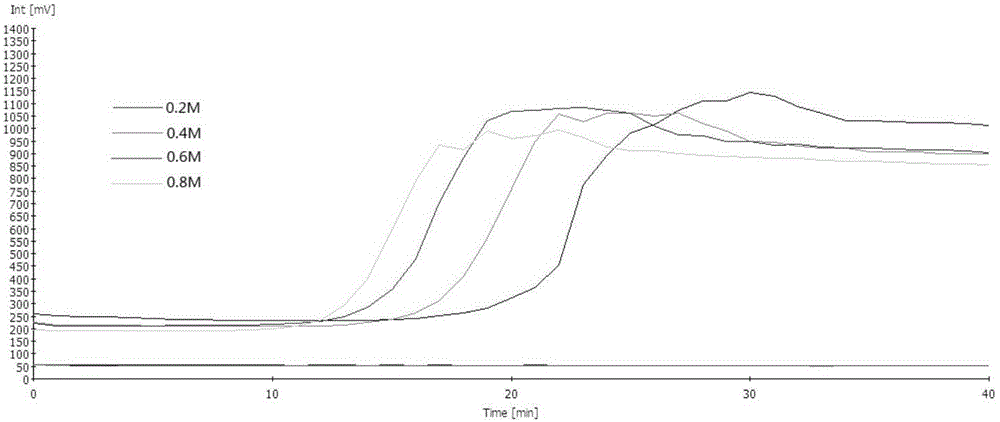Real-time fluorescence LAMP detection method for specific expression human CD46 transgenic pigs and kit
A transgenic pig, real-time fluorescence technology, applied in the field of molecular biology, can solve the problems of amplification, inability to long-chain DNA, difficult to amplify, etc., and achieve the effects of shortened reaction time, high specificity and high sensitivity
- Summary
- Abstract
- Description
- Claims
- Application Information
AI Technical Summary
Problems solved by technology
Method used
Image
Examples
Embodiment 1
[0061] Example 1 Optimization of LAMP reaction system conditions
[0062] LAMP is a 25μL reaction system, and the general components and concentrations are initially determined: 2.5μL 10×Isothermal buffer (including: 20mM Tris-HCl, 50mM KCl, 10mM (NH 4 ) 2 SO 4 , 2mM MgSO4, 0.1% Tween-20), 0.8M betaine, 6mM MgSO4, 1.4mM per dNTPs, 8U Bst DNA polymerase, 0.5μL SYBR Green I (25×), two internal primers each 1.6μM, two Each outer primer is 0.2 μM, two loop primers are 0.8 μM, and 1 μL DNA template. The betaine, magnesium ion concentration, dNTPs concentration, primer concentration and ratio were optimized.
[0063] (1) Optimization of magnesium ion concentration: Mg in the LAMP reaction system 2+ (MgSO 4 ) final concentrations are: 2mM, 3mM, 4mM, 5mM, 6mM, 7mM, 8mM, that is, add 25mM MgSO to the reaction system 4 In order: 0μL, 1μL, 2μL, 3μL, 4μL, 5μL, 6μL. Repeat the experiment to determine the optimum concentration ( figure 1 ).
[0064] The results show that with the i...
Embodiment 2
[0071] Embodiment 2 Sensitivity experiment
[0072] The CD46 positive plasmid was diluted 10 times, and the dilution was 10 -1 to 10 -7 Seven dilutions, according to the LAMP reaction system optimized in Example 1, were used for LAMP amplification with ESEQuant TS tube scanner to determine the lowest dilution of the real-time fluorescent LAMP detection established in this study (see Figure 5 ); while using F3 and B3 as primers, research the sensitivity of ordinary PCR detection (see Image 6 ),Compare.
[0073] Sensitivity analysis results showed that the positive plasmid for CD46 was diluted to 10 -5 Dilution, when the concentration is 6pg / μL, the real-time fluorescence LAMP method can still detect the amplification curve, that is, the lowest detection concentration is 6pg / μL; ordinary PCR can only detect 10 -3 Dilution, the minimum detection concentration is 600pg / μL, thus confirming that the detection sensitivity of real-time fluorescent LAMP is 100 times that of conve...
Embodiment 3
[0074] Embodiment 3 specificity experiment
[0075] Using positive plasmids of CD46, CD39 (insulin-specific expression gene), LEA29Y (a novel fusion protein gene that efficiently inhibits T cell activity), and water as templates, the LAMP reaction system optimized in Example 1 was carried out with ESEQuant TS tube scanner LAMP amplification to determine the specificity of the detection method ( Figure 7 ).
[0076] The results showed that the real-time fluorescent LAMP detection method established in this study only had a specific amplification curve for the CD 46 gene, but no amplification curves for CD 39, LEA29Y, and water, showing a negative reaction, indicating that the method has good specificity.
PUM
 Login to View More
Login to View More Abstract
Description
Claims
Application Information
 Login to View More
Login to View More - R&D
- Intellectual Property
- Life Sciences
- Materials
- Tech Scout
- Unparalleled Data Quality
- Higher Quality Content
- 60% Fewer Hallucinations
Browse by: Latest US Patents, China's latest patents, Technical Efficacy Thesaurus, Application Domain, Technology Topic, Popular Technical Reports.
© 2025 PatSnap. All rights reserved.Legal|Privacy policy|Modern Slavery Act Transparency Statement|Sitemap|About US| Contact US: help@patsnap.com



